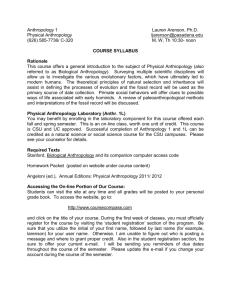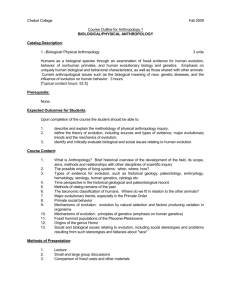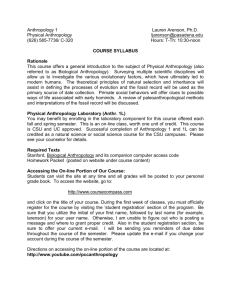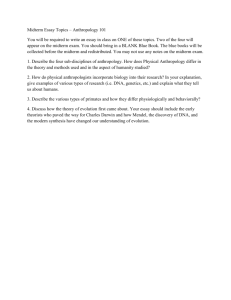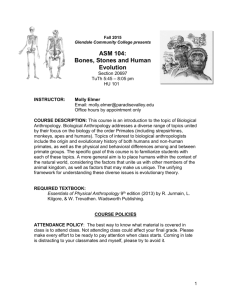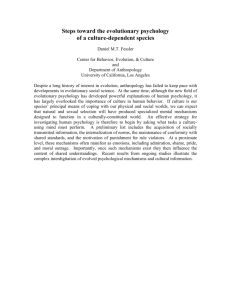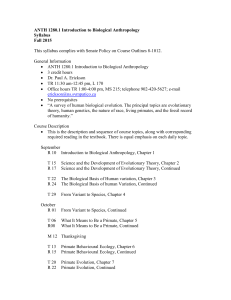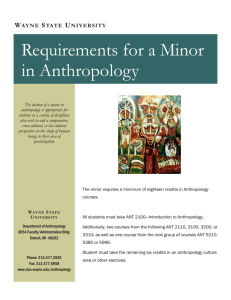Anthropology 1: Introduction to Physical Anthropology
advertisement
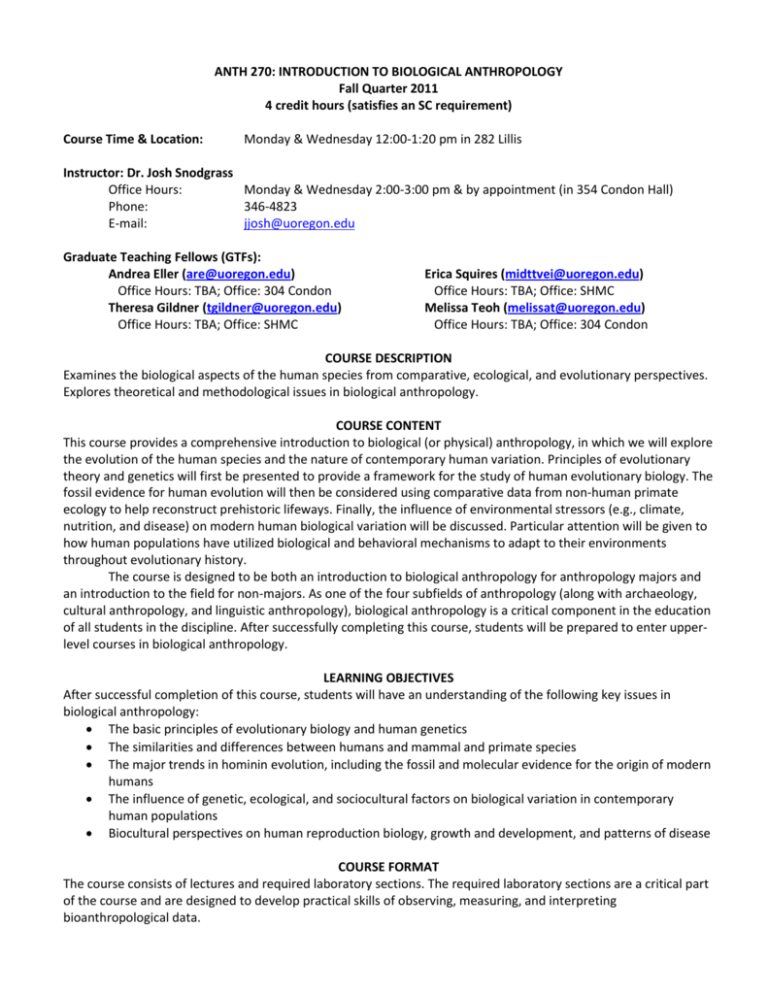
ANTH 270: INTRODUCTION TO BIOLOGICAL ANTHROPOLOGY Fall Quarter 2011 4 credit hours (satisfies an SC requirement) Course Time & Location: Monday & Wednesday 12:00-1:20 pm in 282 Lillis Instructor: Dr. Josh Snodgrass Office Hours: Monday & Wednesday 2:00-3:00 pm & by appointment (in 354 Condon Hall) Phone: 346-4823 E-mail: jjosh@uoregon.edu Graduate Teaching Fellows (GTFs): Andrea Eller (are@uoregon.edu) Office Hours: TBA; Office: 304 Condon Theresa Gildner (tgildner@uoregon.edu) Office Hours: TBA; Office: SHMC Erica Squires (midttvei@uoregon.edu) Office Hours: TBA; Office: SHMC Melissa Teoh (melissat@uoregon.edu) Office Hours: TBA; Office: 304 Condon COURSE DESCRIPTION Examines the biological aspects of the human species from comparative, ecological, and evolutionary perspectives. Explores theoretical and methodological issues in biological anthropology. COURSE CONTENT This course provides a comprehensive introduction to biological (or physical) anthropology, in which we will explore the evolution of the human species and the nature of contemporary human variation. Principles of evolutionary theory and genetics will first be presented to provide a framework for the study of human evolutionary biology. The fossil evidence for human evolution will then be considered using comparative data from non-human primate ecology to help reconstruct prehistoric lifeways. Finally, the influence of environmental stressors (e.g., climate, nutrition, and disease) on modern human biological variation will be discussed. Particular attention will be given to how human populations have utilized biological and behavioral mechanisms to adapt to their environments throughout evolutionary history. The course is designed to be both an introduction to biological anthropology for anthropology majors and an introduction to the field for non-majors. As one of the four subfields of anthropology (along with archaeology, cultural anthropology, and linguistic anthropology), biological anthropology is a critical component in the education of all students in the discipline. After successfully completing this course, students will be prepared to enter upperlevel courses in biological anthropology. LEARNING OBJECTIVES After successful completion of this course, students will have an understanding of the following key issues in biological anthropology: The basic principles of evolutionary biology and human genetics The similarities and differences between humans and mammal and primate species The major trends in hominin evolution, including the fossil and molecular evidence for the origin of modern humans The influence of genetic, ecological, and sociocultural factors on biological variation in contemporary human populations Biocultural perspectives on human reproduction biology, growth and development, and patterns of disease COURSE FORMAT The course consists of lectures and required laboratory sections. The required laboratory sections are a critical part of the course and are designed to develop practical skills of observing, measuring, and interpreting bioanthropological data. BLACKBOARD A Blackboard site will be maintained for this class, which will be your main source for course information, documents, and announcements. Make sure that you regularly check your Blackboard-linked e-mail account. ACCOMMODATIONS Appropriate accommodations will be provided for students with documented disabilities. Please make arrangements to meet with me or your GTF to discuss these accommodations. REQUIRED READINGS Jurmain R, Kilgore L, Trevathan W, Ciochon RL. 2012. Introduction to Physical Anthropology (13th edition; 2011-2012), Thomson/Wadsworth. (Available at the Duckstore) Carroll SB. 2009. The day the Mesozoic died (Chapter 8). In: Remarkable Creatures: Epic Adventures in the Search for the Origins of Species. Mariner Books. pp. 142-159. (Week 1) (Available on Blackboard) EXPECTATIONS AND GRADING Regular attendance at lectures and laboratory sections, as well as participation in laboratory activities, is required. Course readings are required and are essential to passing exams, completing lab assignments, and participating in lab section activities. Your grade in the course will reflect performance on: an online quiz; written, in-class midterm and final exams; discussion section attendance; a lab practical; and a short write-up of 4 laboratory exercises. Online Quiz (end of Week 3) 10% Midterm Exam (Wednesday, 10/26) 25% Final Exam (Friday, 12/9) 25% Lab/Discussion Section Attendance 10% Lab Practical (Week 8) 10% 4 Short Lab Exercise Write-Ups @ 5% each 20% The midterm and final exams will cover lectures, readings, videos, and lab section materials. Exams will include multiple choice, matching, and short answer (2-3 sentences) sections. The final exam will be cumulative, but will emphasize material from the second half of the course. Exams and assignments must be taken/turned in at the scheduled time—under no circumstances will make-up exams or assignment extensions be given without a documented excuse (e.g., signed note from your doctor). If you will not be able to take an exam or turn in an assignment, you must notify me in advance (preferably by e-mail). Material on the exams may be different than that presented in the textbook, and may only be covered during class lecture and lab sections. Therefore, you are advised to arrange to get course notes if you miss a class. Grades will be assigned as follows: A = 90-100%, B = 80-89%, C = 70-69%, D = 60-69%, F < 60% (with minus and plus grades assigned at appropriate cutoffs). The grading system used in this course is as follows: A – Outstanding performance relative to that required to meet course requirements; demonstrates a mastery of course content at the highest level. B – Performance that is significantly above that required to meet course requirements; demonstrates a mastery of course content at a high level. C – Performance that meets the course requirements in every respect; demonstrates an adequate understanding of course content. D – Performance that is at the minimal level necessary to pass the course but does not fully meet the course requirements; demonstrates a marginal understanding of course content. F – Performance in the course, for whatever reason, is unacceptable and does not meet the course requirements; demonstrates an inadequate understanding of the course content. CLASS SCHEDULE Topics Week Dates 1 9/26 Course Overview & Introduction to Anthropology; The Big Questions; The Scientific Method 9/28 Evolution—History of an Idea; Darwin & the Changing World; Video Segment (Galapagos; ~25 min) Chapter 2 Lab: Introduction to the Scientific Method & Evolutionary Biology (Write-up of this lab is due by the end of Week 2 lab) Natural Selection; Biological Basis of Life/DNA; Video Segment (What Darwin Never Knew; ~15 min) Lab Reading: Carroll 2009 Chapter 3 2 10/3 10/5 3 10/10 10/12 Biological Basis of Life (cont’d); The Inheritance of Traits & Basic Genetics; Video Segment (What Darwin Never Knew; ~20 min) Lab: Genetics & Rules of Inheritance (Write-up of this lab is due by the end of your Week 3 lab) The Modern Evolutionary Synthesis; Microevolution vs. Macroevolution; Systems of Classification What It Means to be Mammal; Video: Life in the Trees Required Reading Chapter 1 Chapter 4 (pp. 81-98) Chapter 4 (pp. 98-109) & Chapter 5 Chapter 6 Lab: Primate Adaptation & Classification 4 10/17 10/19 5 ***ONLINE QUIZ – To be taken anytime 10/15-10/18; covers everything from weeks 1-3*** Our Heritage as Primates; Primate Adaptation & Classification Primate Behavior & Ecology; Primate Reproductive Strategies; Video Segment (Evolution: Why Sex?; ~20 min) Review Session by Dr. Snodgrass (Thursday, 10/20 @ 5-6 pm) 10/24 Lab: Primate Behavior & Review for the Midterm Exam What We’ve Learned about Living Primates; Video: Ape Genius 10/26 Midterm Exam Lab: Video: Becoming Human—Part 1 (First Steps) Lab/Homework Assignment: Introduction to the Human Skeleton (Due by the end of your Week 6 lab) Chapters 7 & 8 Week Dates 6 10/31 What Makes Us Human?; Bipedalism—Its Evolution & Anatomical Changes; Why did Bipedalism Evolve? 11/2 Paleoanthropology & The Fossil Record; Dating Method; The Big Picture of Human Evolution; The Earliest Hominins; Video Segments (Becoming a Fossil & Radiometric Dating; ~10 min) 7 11/7 11/9 8 11/14 11/16 9 10 11/21 Required Reading Chapters 10 & 11 (pp. 311-316) Chapter 11 (pp. 316-339) Lab: Ape/Human Differences & Early Hominins Australopithecus & Paranthropus; Video Segment (Ardipithecus; ~10 min) Origin & Evolution of the Genus Homo; Homo erectus; Dispersal & Brain Evolution; Neandertals Chapters 12 & 13 Lab: Homo, Neandertals, & Modern Humans (Lab assignment is due by the end of your Week 8 lab) Neandertals (cont’d) Video: Becoming Human – Volume 3 Origin & Dispersal of Modern Humans; The Human Revolution; Upper Paleolithic Culture; Video Segment (ScienceNOW: Lice & Human Evolution; ~10 min) Chapter 14 Lab: Lab Practical (Quiz on the human skeleton & hominin fossils [Labs 5-7]) Origin & Dispersal of Modern Humans (cont’d); Video Segment (What Darwin Never Knew; ~25 min) 11/23 Contemporary Human Biological Variation; Concept of Race Chapter 15 11/28 No Lab—Thanksgiving Holiday Explaining Human Variation; Are Humans Still Evolving?; Human Adaptation & Adaptability; Heat & Cold Adaptation Chapter 16 11/30 11 Topics 12/9 Human Adaptation (cont’d): High Altitude Adaptation; Skin Color & Solar Radiation; Why It Matters Lab: Contemporary Human Variation; Anthropometry & Body Proportions; Food & Health Final Exam (Friday, 10:15 am – 12:15 pm; in Lillis 282) The final exam will be cumulative, but will emphasize material from the second half of the course (Weeks 6-10). Conclusion
